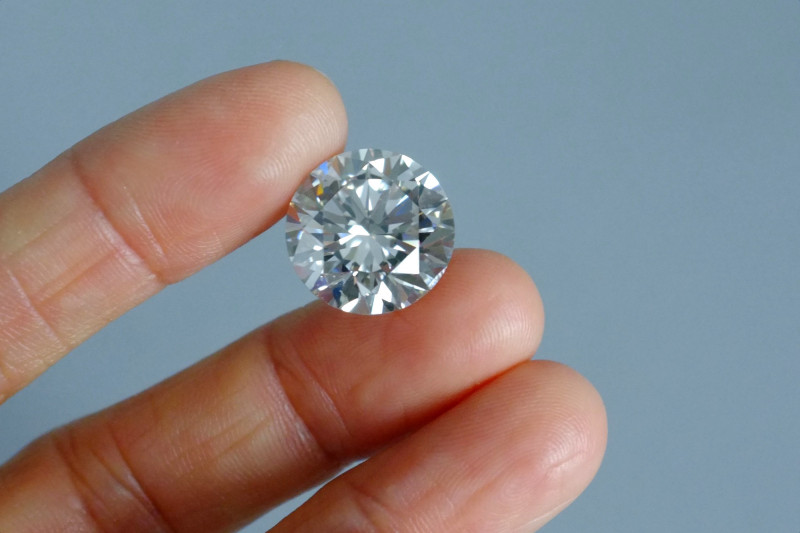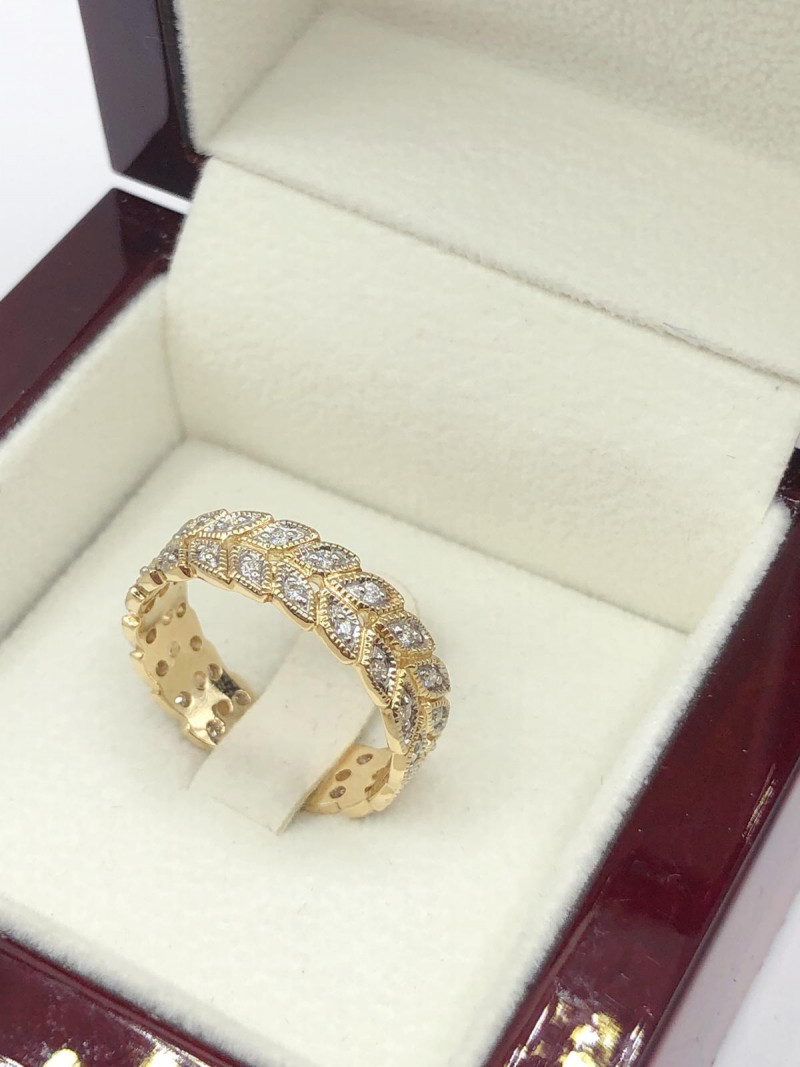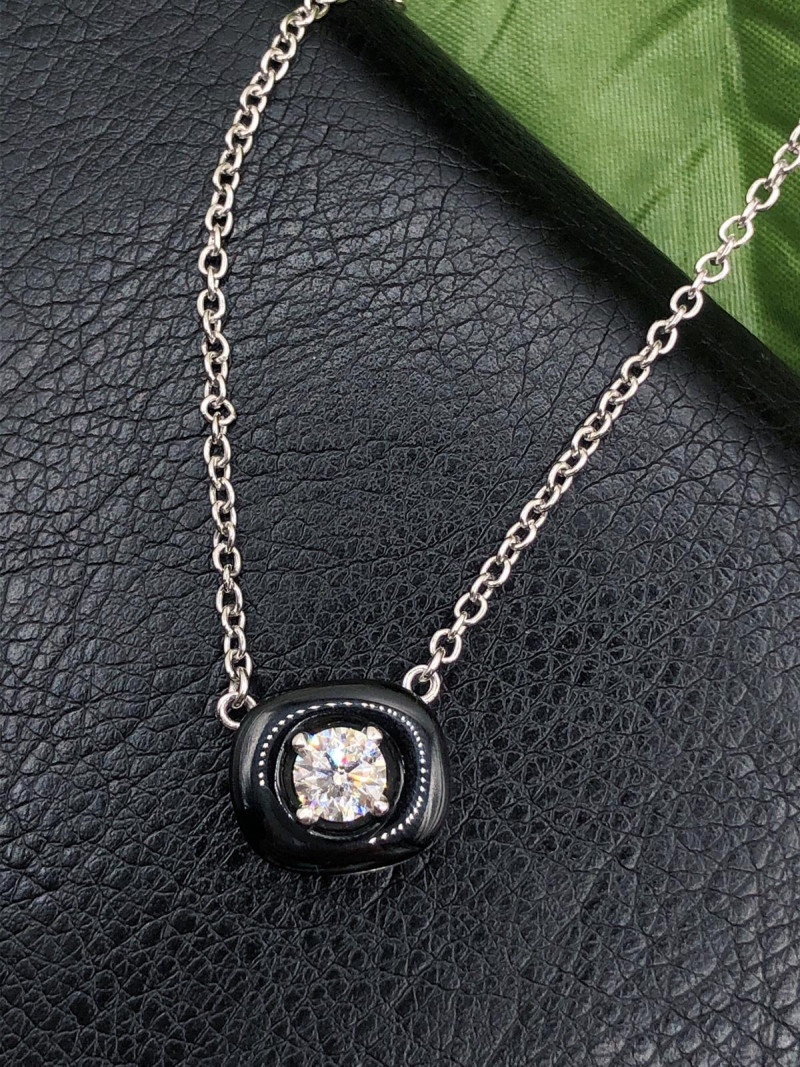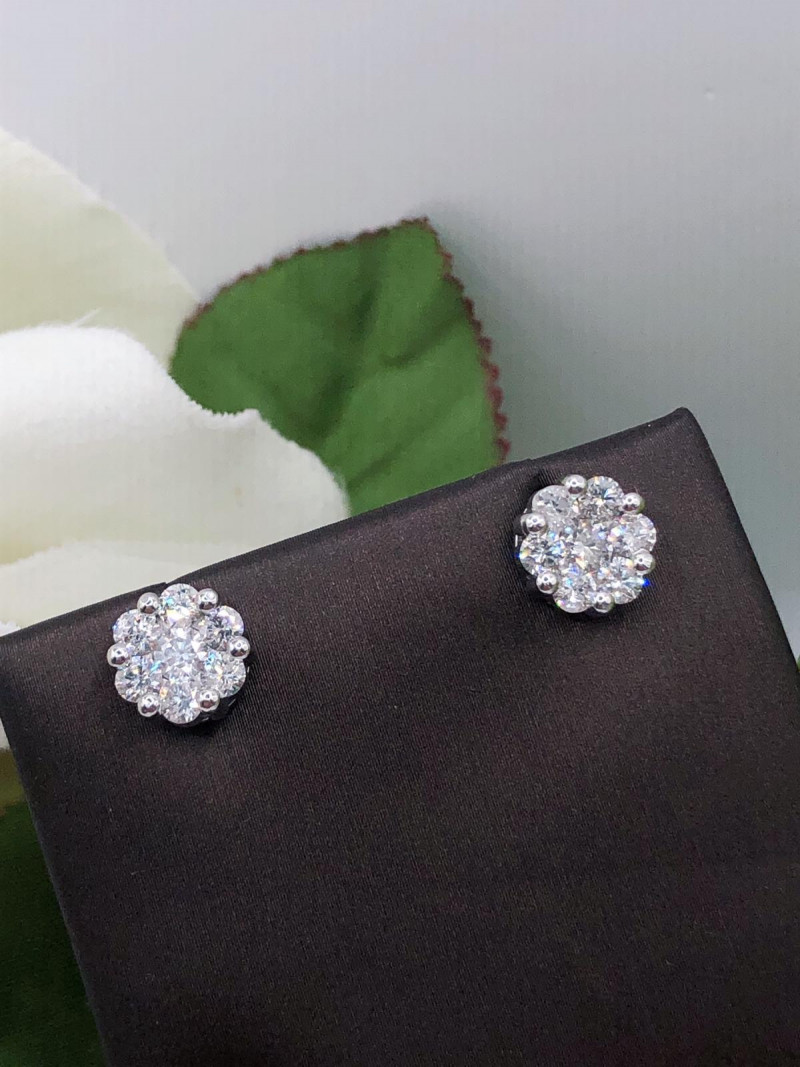
What Is A Moissanite Diamond? Value, Properties, Pros & Cons
 Moissanite is a colorless, transparent gemstone often used as an alternative to diamond. For this reason, the gem is sometimes called “moissanite diamond,” though it’s a completely separate stone.
Moissanite is a colorless, transparent gemstone often used as an alternative to diamond. For this reason, the gem is sometimes called “moissanite diamond,” though it’s a completely separate stone.
Though naturally formed moissanite exists, virtually all moissanite gems available today are synthetic (created in a lab).
There are many alternatives to diamonds, be it for engagement rings or other diamond jewelry. Some examples are cubic zirconia, zircon, and sapphire. In recent years, moissanite has climbed the rankings as one of the top diamond alternatives.
But what is moissanite? Where did it come from, and how does it compare to diamond? We’ll answer all your questions in this moissanite guide!

What Is Moissanite?
Moissanite is a silicon carbide mineral first discovered in a meteorite crater in Arizona, USA. Natural moissanite is incredibly rare, only found so far in meteorites and occasionally in Earth’s upper mantle.
Because of its rarity, the market has turned to synthetic moissanite.
Other terms for “synthetic” include man-made, lab-grown, and lab-created. Synthetic moissanite, like any synthetic gemstone, is created in a lab but possesses the same physical and chemical properties as natural moissanite.
How Is Moissanite Made?
The formation process for natural moissanite is somewhat unclear, as many stones came to Earth on meteorites. But scientists believe it likely forms under high heat and pressure, so these conditions are often replicated for creating synthetic moissanite.
Though methods differ between labs, one of the most common methods is the Lely process.
The Lely process for synthetic moissanite starts with silicon carbide powder. This powder goes on a graphite crucible, a container for heating or melting materials like metals.
From there, they remove oxygen and any other vapors or gasses with Argon gas. Then, they heat the crucible to around 2,500 °C (4,530 °F). The silicon carbide changes to vapor that deposits onto a central graphite rod, gradually cooling into a crystal.
Though the creation has been perfected over time, it still generally takes 1-2 months to make one gem. Some big-name producers include Charles and Colvard, Amora Gems, and Harro Gems.
What are the finished moissanite’s properties?
Pictured above: Synthetic moissanite crystal | Image credit: Lamiot; Creative Commons Attribution-Share Alike 4.0 International license
Moissanite Mineral Properties
Composed of silicon carbide, moissanite’s formula is SiC. Silicon carbide, or “carborundum,” has a range of industrial uses, some in the jewelry sector. Most notably, carborundum is used as a semiconductor and abrasive, but it’s rarely found naturally — a conundrum that plays into moissanite’s history.
While the colorless form is most well-known, moissanite can also naturally form in yellow, black, or green. Synthetic moissanite can be virtually any color.
Here are the other moissanite mineral properties:
Crystal structure: Hexagonal
Luster: Adamantine to metallic
Transparency: Transparent
Refractive index: 2.59-2.69
Density: 3.21-3.22
Cleavage: Indistinct on [0001]
Fracture: Conchoidal
Streak: Greenish-gray
Luminescence: Sometimes weak or moderate fluorescence; Orange in LW-UV & rarely SW-UV; Thermoluminescent (heat-induced);
Pleochroism: Weak; Light blue to very light blue or indigo
Mineralogy aside, where did moissanite originate from?
Moissanite History
French chemist Dr. Henri Moissan first discovered moissanite in 1893. Searching for a crystal for industrial use, he ended up in Canyon Diablo, Arizona, USA where he found tiny stones he mistook for diamonds in an ancient meteorite crater.
Meanwhile in 1890, American chemist Edward Acheson was trying to create synthetic diamonds but accidentally made silicon carbide, dubbing it “carborundum.” This process became the “Acheson Process.”
By 1904, Moissan realized his samples were natural silicon carbide. Tiffany gemologist George Kunz named the stone “moissanite” after Moissan in 1905.
The first reported non-meteoric sources of natural moissanite emerged in the 1950s, inside rocks in Wyoming, USA, and Yakutia, Russia.
Starting in 1987, Cree Research, Inc. in North Carolina has pioneered mass-manufacturing synthetic moissanite.
How long has moissanite been on the market? Moissanite has been available to the masses since 1995, when the company C3, Inc. (now Charles & Colvard) first made synthetic moissanite commercially available.
However, synthetic moissanite gems first emerged around 1980. For years, only jewelers and collectors knew about moissanite. Many chose not to try marketing or selling it because of the competition it would introduce with their top-seller: diamonds.
According to 2021 research from The Knot, moissanite is the second most popular choice for engagement ring stones after diamond, increasing 9 percent (from 2019) as a non-diamond gemstone choice.
But how do moissanites and diamonds compare?
 Pictured above: white moissanite gemstone
Pictured above: white moissanite gemstone
 Pictured above: white diamond gemstone
Pictured above: white diamond gemstone
Moissanite vs. Diamond
If you look at a moissanite and diamond next to each other, they may seem indistinguishable.
Can you tell the difference between diamond and moissanite? Only if you’re a trained expert with the right tools. Even under a standard diamond tester pen, moissanite will often pass as a diamond.
So, what are the differences between moissanite and diamond?
Color & Clarity
Moissanite, like diamond, is traditionally colorless but often has yellow to brown undertones. Both stones may be treated to remove obvious undertones.
Colorless moissanite may appear somewhat blue or green under natural lighting, so always look at it under different lighting sources before buying.
Both moissanites and diamond are available in virtually any color, though most of moissanite’s brighter color range comes from treatments. Still, the highest-value moissanites are the most colorless.
Clarity-wise, diamonds and moissanites are graded on similar clarity scales, their grades dependent on visible inclusions.
Given the refined process for creating moissanite, most will have great clarity. Meanwhile, natural diamonds with the same clarity are rarer and pricier.
Here’s a related fun fact: moissanite has been found as an inclusion in diamonds!
Sparkle
While the right cut can lead to maximum sparkle, a gem’s inherent physical properties also play a role.
Brilliance is the white light reflected from inside the stone. A higher refractive index means higher brilliance, and moissanite comes out on top with a refractive index of 2.59-2.69 (compared to diamond’s at 2.41-2.42).
Dispersion, or fire, is the amount of colorful light a gem reflects. Moissanite’s dispersion is 0.104, over twice the fire of diamond at 0.044!
Another factor to look at is birefringence, or double-refraction. Some stones have two refractive indices, allowing for pleochroism. Moissanite is birefringent, while diamond is not.
An important aspect of moissanite to keep in mind is its “disco ball” effect. Some buyers consider its rainbow-esque sparkle to be too flashy or tacky, while others claim it leads to more compliments than they got from their diamond rings.
Durability
You probably know diamonds are the hardest gemstones, ranking at 10 on the Mohs mineral hardness scale. But is moissanite durable? Yes!
Moissanite ranks just below diamond in hardness at 9.25 to 9.5 — higher than ruby and sapphire!
However, hardness is only resistance to scratching.
Tenacity is a gem’s resistance to breaking or chipping. Diamonds have brittle tenacity, while moissanites have excellent tenacity.
Cleavage describes how easily a gem will split along certain axes (cleavage planes). Perfect cleavage is the easiest to split, and diamonds have perfect cleavage in 4 directions, making them vulnerable to split or even shatter if hit at any of those 4 angles.
In contrast, moissanite has indistinct cleavage (harder to split) in 1 direction, making it less vulnerable to breakage.
Of course, we also have to consider other types of damage.
Ethics
While there are advantages to both natural and synthetic gemstones, one benefit of synthetic gemstones is that they avoid the harmful environmental impacts and often-unethical labor practices of mining.
That said, it’s not completely black-and-white. The conditions of mines, particularly large-scale ones, can sometimes be dangerous, but mining is an established source of income for many people in developing countries. Plus, their mining industry offers a source of federal funding for much-needed developments.
Therefore, lab-created gems are not 100 percent more ethical than natural gems. It will take a larger-scale industry transformation to help those mining communities — rather than just shifting to a new type of production — to ensure an ethical outcome.
You can do your part by choosing a supplier with ethical mining sources. That means safe working conditions, minimal environmental impact, and fair wages.
You can check out our guide on moissanite vs. diamonds for a more comprehensive breakdown of these differences.
One difference we didn’t mention above is price.

Moissanite Price & Value
First, is moissanite more expensive than diamond? Nope, quite the opposite. Moissanites generally cost 10 percent of diamonds of the same quality.
Well, are moissanite “diamonds” worth anything? Definitely. Moissanites aren’t as affordable as some diamond alternatives like cubic zirconia, but moissanite has better durability than other alternatives.
Let’s compare a 1-carat, colorless, round-cut version of moissanite vs. diamond. This type of diamond fetches $2,000 to $25,000, while this type of moissanite goes for roughly $450 to $600.
Interested in a more colorful option? The wholesale price of colored moissanites is even lower at $10 to $80 for 1-carat stones. 0.5- to 1-carat moissanite rings go for $35 to $90 at wholesale and under $250 overall.
What about synthetic diamonds? The average price for a 1-carat synthetic diamond is $800 to $1,000 per carat — much higher than synthetic moissanite.
Where Can I Buy Moissanite?
One of moissanite’s problems, especially compared to diamonds, is limited availability. Almost every jewelry retailer has diamonds available, but this isn’t the same for moissanite.
Since knowledge of moissanite has increased, more retailers like Kohl’s and Amazon have started offering it. The main problem is in-person shopping; finding moissanites at physical locations can be difficult.
Of course, there are pros and cons of online vs. in-person shopping.
Roughly 90 percent of couples buy engagement rings in-person, according to Richline Digital, but the cost of diamonds in-store is generally 40-50 percent higher than online.
A major con of shopping online is not being able to try it on and see it under different lighting.
Ultimately, it’s up to personal preference.
Now, let’s discuss some of the many exciting ways you can wear moissanite!
Types of Moissanite Jewelry
Moissanite’s durability, accessible price, and versatility lends to all kinds of jewelry, including:

Rings
Unsurprisingly, the standard way to sport this gem is a moissanite “diamond” ring, be it a non-diamond engagement ring or otherwise.
Moissanites can be cut into any shape, and their lack of perfect cleavage means virtually any setting is reasonable — bezel, basket, prong, you name it.
Plus, you can use the money you saved by opting for moissanite to splurge on an elaborate pavé, halo, or even double halo style.

Pendants & Necklaces
Another popular choice for moissanite jewelry is a pendant necklace. The most classic choice is a solitaire necklace with a single moissanite. But you can go anywhere with the design, from an entire strand of moissanites to unique moissanite hip hop necklaces.

Bracelets & Watches
Moissanite bracelets range from glamorous moissanite tennis bracelets to minimalist single-moissanite slider bracelets. An encrusted moissanite cuff bracelet is another classic, captivating style.
Popular styles for men are white gold cuban link bracelets with moissanite or moissanite-encrusted watches.

Earrings
Like the jewelry types above, moissanite earrings have lots of potential. Of course, moissanite stud earrings are the standard. But other styles like moissanite studded hoop, chandelier, or crawler earrings will reflect rainbows at every angle.
Regardless of the style, caring for moissanite is crucial to keeping it shining bright (like a diamond, you might say).
Cleaning and Caring for Moissanite Jewelry
Luckily, moissanite’s color and clarity don’t fade. Any dullness can be fixed with cleaning.
Here are the steps for cleaning moissanite:
In a bowl, mix warm water with mild, liquid detergent.
Dip a soft brush (e.g. toothbrush) into the mixture.
Use the brush to lightly scrub the moissanite.
Thoroughly rinse the stone with lukewarm water.
Dry it with a hairdryer, container of rice, or microfiber cloth.
You can wear moissanite in the shower, but the resulting soap build-up may mean cleaning it more frequently.
Does chlorine ruin moissanite? Taking a swim won’t affect moissanite, but chlorine can affect metal settings.

Ready to Marvel in Moissanite?
Moissanite is certainly a top diamond alternative, but it’s also so much more. This gem offers sparkle and shine that will last a lifetime, and you can feel good about making a sustainable choice with this lab-created stone.
Ready to shop? Browse our collection of moissanite jewelry today!
Search the Fashion Encyclopedia
Related Auctions
Related Articles
How to buy a ruby for your ring or pendant,Make sure that you learn as much as you can about Rubies, prior to buying a ring or a setting that you are going to add Rubies to. Like Diamonds, Rubies can be flawed, and imperfect The Ruby is one of the most b
10th Apr 2019
jewelry polish cloth,A magic cloth just doesn’t exist. That being said, there are cloths for silver, gold, platinum, bronze, copper, stainless steel and other metals. Each one should be impregnated with special treatments and chemicals targeted at
10th Apr 2019
Latest Articles
Titanium is a popular jewelry metal known for being lightweight, durable, and affordable. Learn all about titanium, how it compares to similar metals, and the pros and cons of titanium jewelry.
7th Feb 2023
Learn all about tungsten jewelry - from its history and uses to its durability and care. By the end of our guide, you’ll know if tungsten is right for you!
7th Feb 2023
Thinking about adding some timeless white gold jewelry to your fine accessories collection? Here’s all there is to know about sophisticated white gold!
29th Jan 2023




